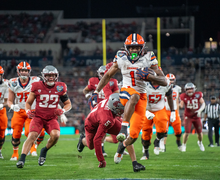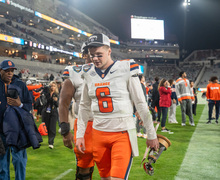How media portrayal of Islam and Muslims influences Islamophobia
Devyn Passaretti | Head Illustrator
The media's representation of Muslims and Islam in general has influenced the level of Islamophobia in the United States, according to several members of the Muslim community at Syracuse University.
Editor’s Note: As Islam continues to grow and is more prominent in the public’s eye, The Daily Orange took a look at Muslims and Islamophobia at Syracuse University.
Maheer Azad was 6 years old and in a classroom a few blocks away from the World Trade Center on 9/11.
He was confused, just like everybody else, he said. He was escorted home by security guards just like everybody else, he said, “because we didn’t know why the skies were so dark outside that day.”
But Azad said that people forget he — an American-born Bengali, Muslim and junior at Syracuse University — was a kid, just like many others, on that day.
It has been 15 years since the terrorist attacks of Sept. 11, 2001, and though there has not been another attack with a magnitude of destruction close to that of 9/11 since, for many Muslims in the United States, the skies are once again dark, as oversaturated and negative portrayals of Islam and Islamophobic proposals by presidential candidates stain the media.
Like 9/11, the recent terrorist attacks formulated and executed by radical Muslim extremists in Paris and San Bernardino, California resonate strongly with members of SU’s Muslim community. The attacks are most often brought up in the context of Islamophobia, or the fear of Islam.
This fear — which is often based on a lack of knowledge about the religion, said Gustav Niebuhr, director of the Carnegie Religion and Media Program at Syracuse University — is a phenomenon he said has been present in the U.S. even before 9/11.
It’s also a phenomenon that Niebuhr said is amplified among some people by individual presidential candidates who pander to what they perceive to be the worst fears of the American public.
Zainab Abdali, president of SU’s Muslim Students’ Association and a Pakistan-born Muslim, said Islamophobia tends to surge after terrorist attacks and after presidential candidate Donald Trump makes an Islamophobic remark or proposal.
“Trump is recent, but the media has been circulating these images or this narrative about fearing Muslims for a while,” Abdali said. “So even though now they’re like, ‘Oh, Trump sucks,’ the media has been doing the same thing but just a lot more subtly for a while.”
But, Niebuhr said, this pandering does not affect everyone.
One’s got to remember that there were people who spoke out against that fear-mongering in January and December that was aimed at Muslims. It’s a mix, in other words.Gustav Niebuhr
The mix could be attributed to the many misconceptions about Islam that members of SU’s Muslim community attribute to both media portrayal of Muslims and general ignorance toward the world religion, which has more than one billion adherents in nations ranging from Indonesia to Morocco and beyond, Niebuhr said.
People who have not thought very much about Islam tend to relate the religion with crises in the Middle East, he said, and since media coverage of the Middle East tends to involve expressions of political Islam and extremist organizations that claim to act in the name of the religion, people “never have a chance to sort of get ahead of the story and see what’s in broader context.”
Niebuhr said it’s the nature of the news to follow clashes between nations and armed groups such as the Islamic State, or ISIS. But he added that always seeing violence in the media doesn’t provide a way to understand how the violence began, to whom it is limited and the world of Islam beyond certain communities in the Middle East.
The media is often seen as a watchdog for government, said Ahmed Malik, Muslim chaplain at Hendricks Chapel, but the media should also be acting as a watchdog of what society is getting itself into, he said.
Malik said the lack of honesty among some news outlets that report about Muslims can be harmful to college-aged and younger Muslims and non-Muslims. He recalled a news network segment that featured a so-called “expert” on Islamic law discussing what, according to Sharia law, should be done with the baby of the couple that was behind the San Bernardino attack.
The non-Muslim expert said the child could not go to a non-Muslim family, Malik said, in an attempt to show the detrimental effects of Sharia, rather than having an honest conversation about the societal, political and psychological factors involved in deciding where the child should go.
“(Young Muslims) see that, and some of them are normal, run-of-the-mill Americans who haven’t even read their own religion, and now they’re scared about their religion,” Malik said of the media portrayal of Islam on young Muslims.
Even though they might like to practice it, they might be afraid to practice it or they might not know what to say.Ahmed Malik
The media portrayal of Islam is also detrimental to non-Muslims because it’s comparable to indoctrination, he said, and it’s not easy for busy college students to say, “’OK, let me go out and objectively find out what Islam really is.’”
Instead, Malik said, non-Muslims may leave with an explanation on the religion that’s being shown on TV.
Another harmful media depiction of Muslims is the difference in the way the media portrays white mass shooters and Muslim mass shooters, said Sabreen Mere, a junior policy studies major at SU.
“If you look at white shooters who are mass shooters typically in the United States, that is a form of domestic terrorism and those people tend to have mental issues,” Mere said.
“But if you brought forward somebody with a brown face, they immediately think, oh, terrorism or ISIS or Muslim,” she continued. “So it’s really the label that they’re putting on these people and it has nothing to do with who they are individually.”
Mere said she was subject to Islamophobic remarks before college. When she was 18, a man approached her and asked her a series of questions: “’If the cash register opens, is it going to explode? Are you part of ISIS? Are you part of al-Qaeda?’” she recalled.
Several other Muslim students at SU discussed their experiences with Islamophobia — from being called a “bomb threat” to “Osama’s (bin Laden) cousin” to “Taliban” to “Saddam’s (Hussein) brother.”
But most of these students said the experiences haven’t necessarily translated to their time at SU. One student, Abdali, said she was called a “bomb threat” by a floormate her freshman year, but others said their encounters with Islamophobia took place off campus.
“I think it’s not really just a Muslim thing; I think it’s a diversity thing,” Abdali said. “I think that it is an issue if there’s one person of color in an entire classroom.”
Published on February 9, 2016 at 1:27 am
Contact Alexa: atorrens@syr.edu





